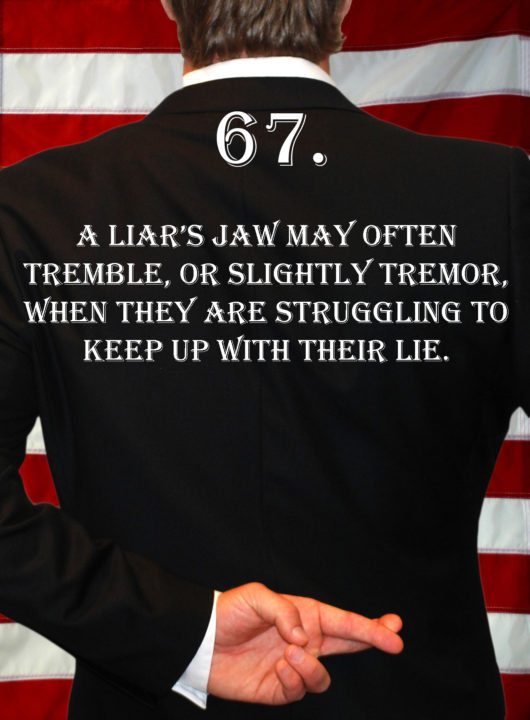
Deception Tip 67:
A liar’s jaw may often tremble, or slightly tremor, when they are struggling to keep up with their lie.
Listen To The Podcast!
E67 – Jaw Tremble – Deception Tips Podcast – Click Here To Subscribe
Podcast Transcript
Hello and welcome to the Deception Tips podcast where you will learn amazing cues to detect deceit that will help you read people like never before. I’m your host Spencer Coffman, let’s get started.
Hello and welcome to episode 67 of the Deception Tips podcast. Thanks for listening and I really hope that you are taking advantage of everything we have to offer and that you are practicing each of these deception tips and noticing them on yourself. Last time, we spoke of a behavior that is in the breathing realm, so when liars tell lies they have to do two things.
Number one is they have to move their lips, number two is they have to breathe, that isn’t entirely a hundred percent true because sometimes when people lie, they may hold their breath, which is a sign of deception.
Sometimes they may say nothing at all and only exhibit body language such as when you are trying to suggest answers or guess answers and watch for their reactions.
They may not be speaking but their body is still speaking, so generally though they need to breathe, and their lips usually move. That’s why we’ve said over and over again, there are a lot of signs on the lips, we’ve gone over several different ones.
In addition, there are several signs when it comes to breathing and this is why we’ve gone over some of them; there are different breathing patterns and speech patterns, etc.
Anyway, last time we spoke about how they may breathe regularly, and then at the end, they’re going to take a long, deep breath to relax or pacify themselves. This is more of a pacification gesture, you may see it with the puff up of the cheeks, it’s also similar to how liars will breathe and do that long, slow exhale. This isn’t a sigh of relief; it’s more of a breath of relief.
There is a difference between that relieving breath and then just the regular deep, long breath. So, pay attention to those, know those differences and you will be able to detect deception a lot better because you will understand how people breathe. It’s important to pay attention to your own breathing because you obviously breathe a lot, or you wouldn’t be alive.
Therefore, you have first-hand experience with how you breathe and you’re human and the other people are human, so the way you breathe is going to be similar to the way they breathe.
So, if you use yourself to learn from then you can use that knowledge when interpreting what other people’s breathing may mean, so that’s something to keep in mind.
Today, we are going to talk about a different tip, it’s on the face, it’s with the jaw and the mouth and it has to do with the nervousness, the tension, and the fear involved in telling a lie.
You say, wait a minute, fear, yes, people are scared to tell lies, they’re not really scared of telling the lie, they’re scared of what comes after, either the lie doesn’t work, or they get caught.
If they get caught, then they’re afraid of the consequence of whatever they were covering up or whatever they were lying about but they are also afraid of the consequence of being caught in the lie.
Now they have a double consequence, they’re going to be in trouble for what they lied about and they’re going to be in trouble for lying about it, so it’s double.
They’re very afraid, they’re nervous, they’re tense, they’re stressed, etc. In addition, they are also afraid because in their heart or in their mind, they know that lying is not good.
Most humans have a moral compass, their conscious and unconscious, the unconscious is trying to push out the truth, and the conscious is trying to get away with everything. Most people have that internal strife that says lying is not something I should do.
So, of course, they become afraid to do it because it’s not natural for them. Although for those who it is natural, all of these tips really don’t apply very much, those are the pathological liars, the sociopath type, psychopath type, etc.
For them, lying is just an everyday thing, it’s a conversation, it’s something that they do all the time. It doesn’t even matter what the plan is or what’s going on, they are simply going to lie but for other people, lying is unnatural behavior.
So, here it is, the deception tip of today, deception tip 67. A liar’s jaw may often tremble or slightly tremor when they are struggling to keep up with their lie. Here it is again, deception tip number 67.
A liar’s jaw may often tremble or slightly tremor when they are struggling to keep up with their lie. There are a few different points here, their jaw, so you’re watching the jaw, this is the bottom half of their mouth.
You may say, “Well, duh, it is.” I say that because it’s the jaw, not the chin. Obviously, the chin and the jaw are put together, but this is different and it’s not only the lip. The lip may quiver, yes, we’re talking about the entire jaw, so you can watch both. This is a bonus tip; it’s a two-for-one today, two-for-one special.
Anyway, it may tremble, so trembling is like teeth chattering and they’re not really going to chatter but it’s like when you’re cold and your teeth are chattering. That’s how their jaw will be moving but their teeth aren’t going to be chattering. Slightly tremoring means, it may quiver or shake a little bit, it may be tense, you may see it in the muscles that connect the jawbone to the skull at the sides by their ears.
This happens when they are struggling to keep up with their lie, that means it’s when they’re being questioned, it’s when they’re being pushed. Not questioned as in asked a question, it’s when their story is being challenged type of a question, like are you sure or did you really do that? It’s when they’re being confronted.
Most people do not like confrontation, they don’t enjoy it, it’s awkward, it’s stressful for them, so this happens when they’re telling a lie. They’re already stressed and tense then when somebody confronts them about it and puts them in that challenging position, now it’s like an overload of this emotion and then they may tremble or tremor.
It could be a variety of emotions, it could be fear, it could be anger, and it could also be sadness, like when you’re afraid and you cry type of fear. There are a lot of different things that go into this and the reasons that they may happen, but it’s important that you watch for it and see it all the time. We’re going to dive into a lot more about it coming up right after this.
People are always being fooled by lies because they don’t know how to spot them. When more people like the Deception Tips Facebook page fewer people will be fooled by lies.
Welcome back to deception tip episode number 67 where we are talking about the jaw and how when people lie, when they are challenged in their lie or pushed a little bit, a little beyond what they think is reasonable, a little bit to overwhelm them, they may experience trembling or quivering of the jaw.
It may tremble, it may tremor, it may shake, whatever word you want to use, their jaw may exhibit that behavior due to a variety of emotions that they may be going through when they are challenged.
It is important to note that this isn’t a response to when someone is yelling at someone. Like if there’s an interrogation going on and the person doing the interrogating, he or she is screaming at the person, yelling at him, calling him names, telling him he’s worthless, all kinds of insults.
The person who is lying, the suspect is trembling or has quivering of the jaw or any of these behaviors, that doesn’t mean they’re lying.
That just means they’re afraid or they’re scared and they’re crying or they’re sad, they’re beating up, they’re broken down because of what the target is doing, they should never be doing something like that.
So, this happens when it’s legitimate, when it really means something, when it means or could mean deception, or that they are being withholding or deceptive.
It’s happening out of the blue such as when you push somebody and then all of a sudden, they start crying and you’re like, “Whoa, what’s going on?” They have some pent-up emotion and something you said triggered some past memory that made them cry and you didn’t even know about it.
That’s the type of response we’re looking for here, that’s the type that you’re going to see when you all of a sudden push them and say, “No, I don’t believe that that’s what happened because I was there at this time and I saw this and this and that doesn’t match up with your story.” All of a sudden, they start trembling and shaking and you’re like, whoa, ok, something’s going on.
That’s the type of response, it’s somewhat out of the blue, it’s when they’re pushed a little bit when they’re challenged when they’re questioned. All of a sudden, it’s like the floodgates open up, the waterworks start, and they may tremble, they’re afraid because they realize that they might be about to get caught in their lie.
They’re scared of being caught and they’re scared of what’s going to happen when someone finds out that they are lying and then the consequences of the initial action and of lying.
They don’t know what’s going to happen, it’s the uncertainty, and uncertainty is a killer. When people don’t know, that is the most powerful tool that you can use to get them to do something or to say something. When they’re not sure of what’s going to happen people are afraid, they want to know, they want to be comfortable in that, they want that security.
If you take away that security you take away a lot more than just that, you’re taking away a mindset, a feeling of comfort, of at-homeness. They’re going to be uncertain then they’re going to be afraid, they’re going to be stressed, they’re going to be tense, etc.
Therefore, that is a powerful tool you can use, people like that security. When you take that away from them, they may start to exhibit other behaviors.
You can use this to your advantage by getting them to tell the truth, so what you can say is you can show them exactly what will happen when you find out the truth.
You give them the security of knowing what will happen, you say, if I find out what happened, this is what I’m going to do about it. This is what’s going to go on this and this and this and you’ll be providing them with the security in the truth. Then they may be more persuaded to tell the truth rather than to continue lying.
It’s also important to note that if in fact that they are a little bit too overwhelmed they may not even say anything, you’ll just have to rely on the body language that they’re exhibiting. That jaw may be trembling, they may be getting even further down, they may start crying, they may shake, they may break down entirely but keep in mind that you need to be aware that this could also happen falsely.
Somebody could start crying in there just hoping that you’re going to let them go or you’re going to let them off the hook. This is why it is very, very important that you look for patterns and clusters of behavior, so if you see their jaw trembling, that’s a slight fear or sadness type of behavior. Look for sadness in their eyes, look for fear in their eyes, look for those responses, look for other behaviors around the body.
If they truly are scared of something or of what’s going on, then they may be exhibiting some of those stress and tension relief behaviors. Things such as bouncing their legs up and down up and down up and down like a crazy person, they may be bouncing both of them not even just one, that was episode 30. They may also be doing stuff such as massaging their neck because it might be getting tense, that was in episode 38 we spoke of that.
They might also be doing things with their hands like massaging them or ringing them to release that stress and tension, we talked about those in episodes 52 and 51.
They could be doing any of these stress relief, tension, and anxiety behaviors in addition to that jaw trembling, in fact, we expect it. When they are truly afraid or scared because you’re challenging them, they’re going to be exhibiting other behaviors.
They may also be doing things like comfort gestures to try to make themselves more comfortable in that situation. Something like a repetitive behavior may be there opening and closing their hand over and over again, maybe they’re rocking back and forth, something like that.
Maybe they’re stroking their arm back and forth with their finger or something like that, it could be anything that is done to give them more comfort.
It’s like the situation where if a person is normally at home and they do certain things then when they go to a new environment, they’re going to do those same things to try to bring that comfort of home to that new environment. That’s what they’re going to be doing, so watch for those in addition to the jaw tremble to complete that cluster of behaviors.
I want to thank you for listening to this week’s episode of the deception tips podcast. I hope that you’ll share it with your friends, subscribe to the feed, check out the videos, the deception tips blog, and take a look at the books I have available and as always, tune in next week for a new deception tip.
Video Transcript
Hey guys, my name is Spencer Coffman, thank you for watching the deception tips videos, they’re all about teaching you how to read people and detect deception so that you will be able to tell if someone is lying to you. Today, we are going to talk about a sign of deception that happens towards the end of the lie. This would happen when the person or the liar is starting to be challenged or questioned.
Questioned not in the fact of when did this happen, tell me about this, where were you? This is questioned as in, they’ve given their story and now, you’re starting to question the validity of what they’re saying. You’re questioning them, you’re personally attacking at whatever it is that they have going on. You aren’t believing what they’re saying, it’s a challenge, you’re challenging them to see what they are going to continue with.
You’ll start to see this behavior, it’s related to a fearfulness behavior and it’s a quivering, it happens on the face and the lip. We’re talking about the jaw, so the jaw may start to tremble or quiver in this instance when they’re being challenged. It’s not going to be a huge instance, but it’ll be very short in a split-second.
So, here it is, this is deception tip number 67. A liar’s jaw may often tremble or slightly tremor when they are struggling to keep up with their lie. So, this is important, it may tremble or tremor. It’s not like teeth chattering when someone is cold and all of a sudden, their jaw is chattering uncontrollably.
It is like a little tremor, it may be a quiver, it may not even be their whole jaw, it might even just be like a lip quiver where it’s almost like they are afraid of something. So, it’s right before they’re about to respond again or right after they have responded and been challenged. This comes in conflict, so something is going on here that is raising the level of conflict.
You may ask, “Well, why is this happening? Why are they all of a sudden fearful or sad or whatever going on with this quivering or this trembling?” Well, think about it, they are under a tremendous amount of stress and pressure and tension. When someone is stressed and tense, they’re like a tea kettle that’s ready to boil or they’re like a fire that’s not been lit yet, but it’s doused in gasoline.
They’re waiting and all that needs to happen is for that match to get struck or that tea kettle to all of a sudden hit boiling point and then it starts whistling or a balloon that’s almost going to pop and burst. It’s right there, they’re on the edge because of all the stress and tension inside of them. So, when you start to challenge that, you are pushing them even further.
Therefore, in some cases, these people may break and they may quiver a little bit and then get it back under control and then deliver that lie again because they know they need to tell this lie or they think they need to tell this lie. They think you need to believe it, so they may be challenged, you may see this quiver or this cowardness or this fear a little bit.
Then all of a sudden, they’re going to buck up and grit their teeth and deliver that lie to try to get out of whatever it is or cover up whatever it is or avoid whatever consequence. So, pay attention to that, it’s very short, it’s almost like witnessing a micro expression except that this one, you may see the jaw move. There is the possibility there that the jaw may actually move in this behavior.
It’s not going to move in terms of speaking, it would move in terms of not like a surprise but almost like a shock, like that type of a movement, back and forth a little bit. It may appear like they’re grinding their teeth, it may even be something really quick like if you just asked me a question and it’s like an internal surprise but I stifled everything else, it’s that quivering or that fear that you’re going to start to see.
So, watch for that in other areas of the body, maybe the eyes, and you will see different patterns and signs around that then you could use that as part of a cluster and a pattern to determine whether or not it’s an act of deception or if it’s something else. Maybe you just made their feelings hurt or made them upset, so pay attention to that, look for the patterns and the clusters of behavior.
If this is your first time watching these videos, I’d love to have you subscribe to the channel on YouTube, feel free to comment with any questions you may have as well. Also, if you’d like some more information, we’ve got books, blog posts, and podcasts all available on spencercoffman.com that are 100% dedicated to teaching you exactly what every body is really saying.
Until next time.






